
A basket is a container that is traditionally constructed from stiff fibers and can be made from a range of materials, including wood splints, runners, and cane. While most baskets are made from plant materials, other materials such as horsehair, baleen, or metal wire can be used. Baskets are generally woven by hand. Some baskets are fitted with a lid, while others are left open on top.

Arundinaria is a genus of bamboo in the grass family the members of which are referred to generally as cane. Arundinaria is the only bamboo native to North America, with a native range from Maryland south to Florida and west to the southern Ohio Valley and Texas. Within this region Arundinaria canes are found from the Coastal Plain to medium elevations in the Appalachian Mountains.
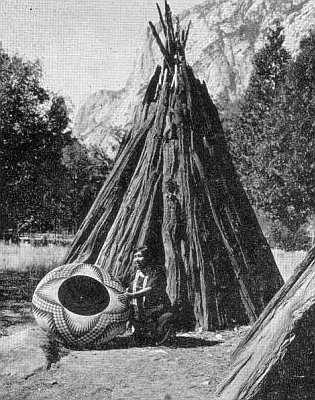
Basket weaving is the process of weaving or sewing pliable materials into three-dimensional artifacts, such as baskets, mats, mesh bags or even furniture. Craftspeople and artists specialized in making baskets may be known as basket makers and basket weavers. Basket weaving is also a rural craft.

Navajo weaving are textiles produced by Navajo people, who are based near the Four Corners area of the United States. Navajo textiles are highly regarded and have been sought after as trade items for more than 150 years. Commercial production of handwoven blankets and rugs has been an important element of the Navajo economy. As one art historian wrote, "Classic Navajo serapes at their finest equal the delicacy and sophistication of any pre-mechanical loom-woven textile in the world."

Lucy Parker Telles was a Mono Lake Paiute - Kucadikadi and Southern Sierra Miwok Native American basket weaver.

Delores E. Churchill is a Native American artist of Haida descent. She is a weaver of baskets, hats, robes, and other regalia, as well as leading revitalization efforts for Haida, her native language.

The visual arts of the Indigenous peoples of the Americas encompasses the visual artistic practices of the Indigenous peoples of the Americas from ancient times to the present. These include works from South America and North America, which includes Central America and Greenland. The Siberian Yupiit, who have great cultural overlap with Native Alaskan Yupiit, are also included.

Mavis Doering was a Cherokee Nation basketmaker from Oklahoma.

Terrol Dew Johnson is a Tohono O'odham basket weaver, sculptor, and health advocate, who promotes Indigenous foods to prevent diabetes.
Annie Antone is a Native American Tohono O'odham basket weaver from Gila Bend, Arizona.
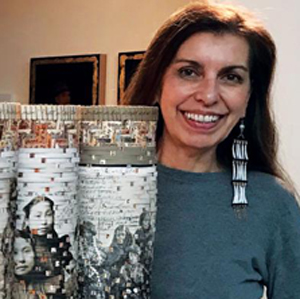
Shan Goshorn was an Eastern Band Cherokee artist, who lived in Tulsa, Oklahoma. Her interdisciplinary artwork expresses human rights issues, especially those that affect Native American people today. Goshorn used different media to convey her message, including woven paper baskets, silversmithing, painting, and photography. She is best known for her baskets with Cherokee designs woven with archival paper reproductions of documents, maps, treaties, photographs and other materials that convey both the challenges and triumphs that Native Americans have experienced in the past and are still experiencing today.
Lena Blackbird is a Cherokee artist living in Tahlequah, Oklahoma. She is best known for her Cherokee double-walled basket weaving. She was the first of the Cherokee basket makers to decorate the tops of her baskets and incorporate vases within her baskets. Blackbird's customary artist mark is seen in a chain pattern on the top of her baskets.
Eva Wolfe was an accomplished basket maker from North Carolina. Wolfe was known for weaving rivercane baskets, a traditional type of Cherokee basketry. She earned special distinction for her accomplishments in doubleweave basketry, a difficult plaited basket weaving technique. She was honored with a number of awards for her achievements as an artist, including the Brown-Hudson Folklore Award from the North Carolina Folklore Society in 1988 and the North Carolina Heritage Award in 1989.

Elizabeth Conrad Hickox was a Wiyot master basket weaver and was considered one of the finest basket-weavers of her time. Her baskets differ from other Lower Klamath baskets through her own unique use of shape, technique, color scheme and design.

Iva Casuse Honwynum is a Hopi/Navajo artist, social activist, and cultural practitioner. A Native American, Honwynum is best known for her woven baskets and figurative sculpture. Honwynum's most important breakthrough was the development of the pootsaya basket, called "a rare innovation in Hopi basketry". She developed the pootsaya during her 2014 residency at the School for Advanced Research in Santa Fe, New Mexico, having been awarded the Eric and Barbara Dookin Artist Fellowship.
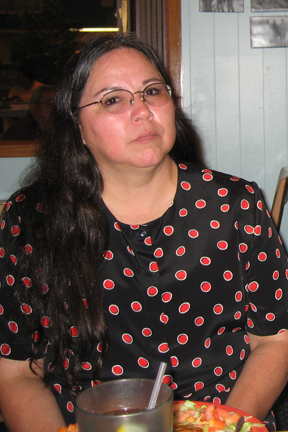
Lisa Telford is a Git'ans Git'anee Haida weaver who creates contemporary garments, shoes and other objects using Northwest Coast style weaving techniques. Her work serves as a commentary on Native identity, stereotypes and fashion.
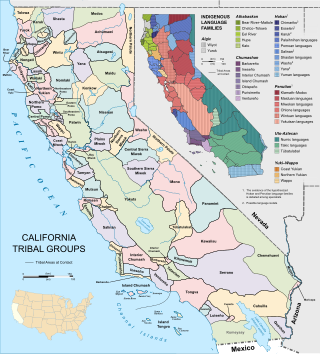
A fully feathered basket is a type of basket crafted by a select group of Indigenous people of California who have traditionally resided in the coastal region of Northern California above San Francisco. The baskets are distinguished by the matted layer of feathers, which completely cover the exterior of the basket. They are highly collectible and renowned for their fine craftsmanship.

Cherish Nebeshanze Parrish is a black ash basket maker and birchbark biter. She is a member of the Match-e-be-nash-she-wish Band of Pottawatomi Indians of Michigan and of Odawa descent.
Don Weeke is an American fiber and gourd artist from Addieville, Illinois best known for combining basketry with gourds using natural materials from the environment. His work is regularly on display nationally at galleries and has been featured in art books, including Fiberarts Design Book 7, The Complete Book of Gourd Craft, and 500 Baskets.
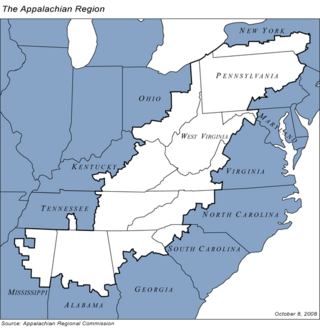
Appalachian folk art is a regional form of folk art based in the Appalachian region in the United States. In an article about the contemporary form of this art, Chuck Rosenak stated, "the definition of folk art is obscure". Folk art is a way to convey the feelings and mannerisms of cultures through handmade visual art and communicates a message to the observer. Though folk art itself was brought to the Americas by Europeans, it has adapted to each region and has cultivated traditions in each region.

















